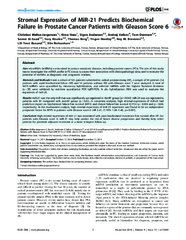Blar i forfatter "Richardsen, Elin"
-
Simultaneous Detection of Zinc and Its Pathway Metabolites Using MALDI MS Imaging of Prostate Tissue
Andersen, Maria Karoline; Krossa, Sebastian; Høiem, Therese Stork; Buchholz, Rebecca; Claes, Britt S.R.; Balluff, Benjamin; Ellis, Shane; Richardsen, Elin; Bertilsson, Helena; Heeren, Ron M.A.; Bathen, Tone Frost; Karst, Uwe; Giskeødegård, Guro F.; Tessem, May-Britt (Journal article; Tidsskriftartikkel; Peer reviewed, 2020-01-16)Levels of zinc, along with its mechanistically related metabolites citrate and aspartate, are widely reported as reduced in prostate cancer compared to healthy tissue and are therefore pointed out as potential cancer biomarkers. Previously, it has only been possible to analyze zinc and metabolites by separate detection methods. Through matrix-assisted laser desorption/ionization mass spectrometry ... -
Spatial differentiation of metabolism in prostate cancer tissue by MALDI-TOF MSI
Andersen, Maria Karoline; Høiem, Therese Stork; Claes, Britt S.R.; Balluff, Benjamin; Marta, Martin-Lorenzo; Richardsen, Elin; Krossa, Sebastian; Bertilsson, Helena; Heeren, Ron M.A.; Rye, Morten Beck; Giskeødegård, Guro F.; Bathen, Tone Frost; Tessem, May-Britt (Journal article; Tidsskriftartikkel; Peer reviewed, 2021-01-29)Background - Prostate cancer tissues are inherently heterogeneous, which presents a challenge for metabolic profiling using traditional bulk analysis methods that produce an averaged profile. The aim of this study was therefore to spatially detect metabolites and lipids on prostate tissue sections by using mass spectrometry imaging (MSI), a method that facilitates molecular imaging of heterogeneous ... -
Stromal Expression of MiR-21 Predicts Biochemical Failure in Prostate Cancer Patients with Gleason Score 6
Melbø-Jørgensen, Christian Nordahl; Ness, Nora; Andersen, Sigve; Valkov, Andrey Yurjevich; Dønnem, Tom; Al-Saad, Samer; Kiselev, Yury; Berg, Thomas; Nordby, Yngve; Bremnes, Roy M.; Busund, Lill-Tove; Richardsen, Elin (Journal article; Tidsskriftartikkel; Peer reviewed, 2014) -
Systolic and diastolic blood pressure, prostate cancer risk, treatment, and survival. The PROCA-life study
Stikbakke, Einar; Schirmer, Henrik; Knutsen, Tore; Støyten, Martin; Wilsgaard, Tom; Giovannucci, Edward L.; McTiernan, Anne; Eggen, Anne Elise; Haugnes, Hege Sagstuen; Richardsen, Elin; Thune, Inger (Journal article; Tidsskriftartikkel; Peer reviewed, 2021-12-22)Background: Inflammation has been linked to prostate cancer and hypertension, but it remains equivocal whether elevated blood pressure (BP) influence prostate cancer risk and survival.<p> <p>Method: Using Cox regression models, we examined the association between prediagnostic BP and prostate cancer risk among 12,271 men participating in the Prostate Cancer throughout life (PROCA-life) study. ... -
Transcription factor PAX6 as a novel prognostic factor and putative tumour suppressor in non-small cell lung cancer
Kiselev, Yury; Andersen, Sigve; Johannessen, Charles; Fjukstad, Bjørn; Olsen, Karina Standahl; Stenvold, Helge; Al-Saad, Samer; Dønnem, Tom; Richardsen, Elin; Bremnes, Roy M.; Busund, Lill-Tove (Journal article; Tidsskriftartikkel; Peer reviewed, 2018-03-22)Lung cancer is the leading cause of cancer deaths. Novel predictive biomarkers are needed to improve treatment selection and more accurate prognostication. PAX6 is a transcription factor with a proposed tumour suppressor function. Immunohistochemical staining was performed on tissue microarrays from 335 non-small cell lung cancer (NSCLC) patients for PAX6. Multivariate analyses of clinico-pathological ... -
Women with fracture, unidentified by FRAX, but identified by cortical porosity, have a set of characteristics that contribute to their increased fracture risk beyond high FRAX score and high cortical porosity
Kral, Rita; Osima, Marit; Vestgaard, Roald; Richardsen, Elin; Bjørnerem, Åshild (Journal article; Tidsskriftartikkel; Peer reviewed, 2018-08-25)The Fracture Risk Assessment Tool (FRAX) is widely used to identify individuals at increased risk for fracture. However, cortical porosity is associated with risk for fracture independent of FRAX and is reported to improve the net reclassification of fracture cases. We wanted to test the hypothesis that women with fracture who are unidentified by high FRAX score, but identified by high cortical ...


 English
English norsk
norsk




